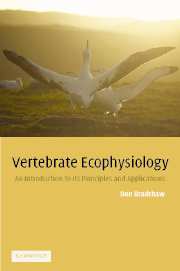Book contents
- Frontmatter
- Contents
- Introduction
- 1 Homeostasis: a fundamental organising paradigm in ecophysiology
- 2 Stress: the concept and the reality
- 3 Basic methods used in ecophysiological studies
- 4 Turnover methodology: theory and practice
- 5 Case studies of stress: incidence and intensity
- 6 Survival in deserts
- 7 Torpor and hibernation in cold climates
- 8 Marine birds and mammals
- 9 Conclusion
- Appendix 1 Population estimation methods
- Appendix 2 Estimation of food intake in Tiliqua rugosa
- Appendix 3 Simultaneous measurement of sodium and potassium concentration in plasma or urine using the IL 143 digital flame photometer
- Appendix 4 Determination of plasma urea nitrogen
- Appendix 5 Radioimmunoassay of testosterone in plasma
- Appendix 6 Preparation of ‘stripped plasma’
- Appendix 7 Radioimmunoassay of testosterone in faeces
- Appendix 8 The comparative method
- Appendix 9 Basic turnover equations
- References
- Index
Introduction
Published online by Cambridge University Press: 05 June 2012
- Frontmatter
- Contents
- Introduction
- 1 Homeostasis: a fundamental organising paradigm in ecophysiology
- 2 Stress: the concept and the reality
- 3 Basic methods used in ecophysiological studies
- 4 Turnover methodology: theory and practice
- 5 Case studies of stress: incidence and intensity
- 6 Survival in deserts
- 7 Torpor and hibernation in cold climates
- 8 Marine birds and mammals
- 9 Conclusion
- Appendix 1 Population estimation methods
- Appendix 2 Estimation of food intake in Tiliqua rugosa
- Appendix 3 Simultaneous measurement of sodium and potassium concentration in plasma or urine using the IL 143 digital flame photometer
- Appendix 4 Determination of plasma urea nitrogen
- Appendix 5 Radioimmunoassay of testosterone in plasma
- Appendix 6 Preparation of ‘stripped plasma’
- Appendix 7 Radioimmunoassay of testosterone in faeces
- Appendix 8 The comparative method
- Appendix 9 Basic turnover equations
- References
- Index
Summary
Ecophysiology is a relatively new discipline and seeks to clarify the rôle and importance of physiological processes in the ecological relations of species in their natural habitat. It has its antecedents in the fields now known as ‘environmental physiology’ and ‘physiological ecology’, both of which developed strongly in the United States in the 1950s and 1960s. Ecophysiology differs principally from both of these in its emphasis on studying animals unrestrained in their natural environment, rather than in laboratory situations where animals are forcibly constrained and often exposed to stressors that may not be obvious, even to the experimenter.
Ecologists often have little training, or interest, in the study of basic physiological processes (such as digestion, respiration, excretion, etc.) and many would dispute that the primary ecological processes structuring populations – those of birth, growth, food acquisition, recruitment, reproduction and death – require any understanding of the physiological processes and mechanisms occurring in the individual animal. Indeed, Andrewartha and Birch (1954), in their seminal text on population ecology, went even further and argued that evolution had nothing to do with ecology! One only needs to cite Theodosius Dobzhanky's oft quoted aphorism that ‘Nothing makes any sense in biology except in the light of evolution’ to realise that this was an extreme view no longer shared by either ecologists or evolutionary biologists (Dobzhansky, 1953).
- Type
- Chapter
- Information
- Vertebrate EcophysiologyAn Introduction to its Principles and Applications, pp. ix - xiPublisher: Cambridge University PressPrint publication year: 2003



